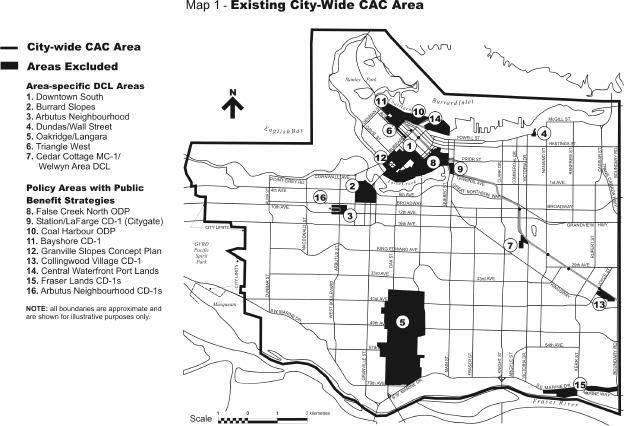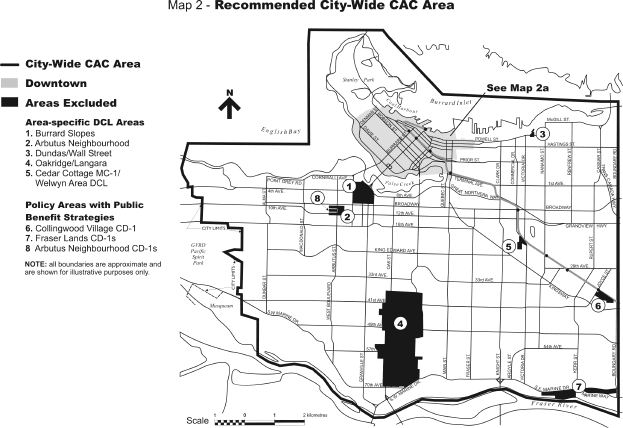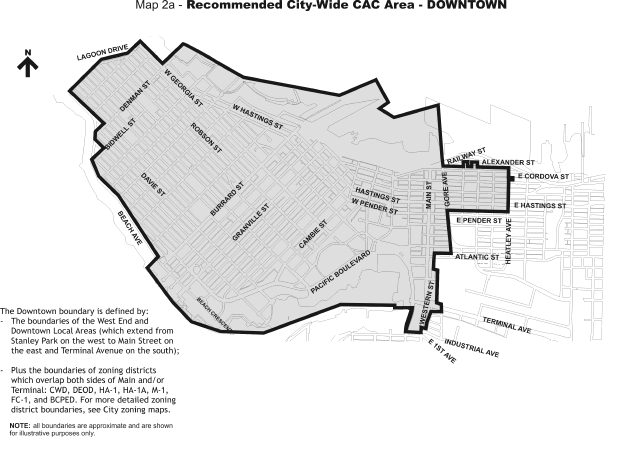|
CITY OF VANCOUVER POLICY REPORT
|
Date: |
January 26, 2004 | |
Author: |
Ronda Howard | |
Phone No.: |
604-873-7215 | |
RTS No.: |
03873 | |
CC File No.: |
1755 | |
Meeting Date: |
February 12, 2004 |
TO: |
Standing Committee on Planning and Environment |
FROM: |
Director of City Plans in consultation with Director of Current Planning |
SUBJECT: |
Financing Growth - Clarifications to new City-Wide Community Amenity Contribution (CAC) Policy |
RECOMMENDATION
A. THAT the boundary of the Downtown negotiated CAC area be defined as follows: the West End and Downtown Local Areas (Stanley Park on the west, Main Street on the east, Burrard waterfront on the north, and Terminal Avenue and False Creek waterfront on the south), and, beyond this, the boundaries of zoning districts which overlap both sides of Main and/or Terminal, as shown on Map 2a in Appendix A.
B. THAT for the 16 sub-areas previously excluded from the City-Wide CAC Area:
i. The 8 sub-areas in the Downtown be included in the City-Wide CAC Area, as shown by comparing Maps 1 and 2 in Appendix A, and the guidelines for negotiated CACs include reference to existing area plans and policies.
ii. The 8 sub-areas outside the Downtown remain excluded from the City-Wide CAC Area, as shown on Map 2; and if there are future rezoning applications that depart from what was anticipated by area-specific plans and policies, an appropriate CAC be determined as part of the rezoning process, having regard to the guidelines described in this report.
C. THAT for False Creek Flats and Grandview-Boundary, the "No CAC" policies for change of use rezonings be rescinded, to be consistent with the City-Wide CAC Policy.
D. THAT, rather than reporting each Non-Standard rezoning to Council to determine if it should be a flat rate CAC or a negotiated CAC, all Non-Standard rezonings be negotiated CACs - unless the applicant requests a report to Council at the beginning of the rezoning process.
GENERAL MANAGER'S COMMENTS
The General Manager of Community Services recommends approval of the foregoing.
COUNCIL POLICY
On June 24, 2003, after a period of extensive research and consultation, City Council approved policies arising from the Financing Growth report. This included replacing the Interim Community Amenity Contribution (CAC) Policy with an updated CAC Policy.
PURPOSE
The purpose of this report is to clarify some details related to implementation of the updated City-Wide CAC Policy, and to reconcile the updated policy with related City policies.
CACs, the subject of this Council report, are community amenities provided through rezonings, to help address growth costs, area deficiencies, and other community needs.
The updated City-Wide CAC Policy is summarized in Table 1. (Note that all new
developments, including rezonings, pay DCLs.)
Table 1: City-Wide CAC Policy in Summary
CAC Approach |
Type of Rezoning |
Non-Standard Rezonings:
|
· Large sites: 2+ acres; 1+ acre in Neighbourhood Centre · Downtown
|
Rezonings exempt from CACs |
· Heritage; social housing and Housing Demonstration Projects; community amenities, public schools; places of worship.
|
Standard Rezonings:
|
· All other rezonings
|
DISCUSSION
The following refinements will simplify the system, reconcile related policies, and more clearly communicate the CAC Policy.
Confirm a Downtown CAC Boundary - Recommendation A
The updated City-Wide CAC Policy, approved by Council in June 2003, states that rezonings on the Downtown peninsula are Non-Standard for CAC purposes - i.e., negotiated CACs rather than Standard/flat rate CACs. Normally, the boundary of the Downtown peninsula would be considered as Main Street on the east and Terminal Avenue on the south, made up of the West End and Downtown Local Areas. However, some zoning districts extend beyond Main and/or Terminal, such as the Downtown Eastside (DEOD ODP). The June Council report described the Downtown peninsula as including the West End, Downtown, and Downtown-Eastside/Strathcona. However, it did not include a precise boundary.
Staff recommend the following as the CAC boundary for Downtown: the West End and Downtown Local Areas plus the boundaries of zoning districts which overlap both sides of Main and/or Terminal. These include the Central Waterfront CWD, Downtown-Eastside DEOD, Chinatown HA-1 and 1A, East False Creek FC-1, M-1 between HA and FC-1, and North False Creek BCPED. (See Map 2a in Appendix A.)
Reconcile CAC Policy for Areas Excluded From the City-Wide Policy - Recommendation B
When the Interim City-Wide CAC Policy was introduced, 16 sub-areas that had their own plans and policies were excluded from the City-Wide Policy. Staff have reviewed these sub-areas, and conclude that 8 of them can be folded into the City-Wide Area while being consistent with existing policies. Map 1 in Appendix A shows the existing City-Wide CAC Area, with the 16 excluded sub-areas, while Map 2 shows the recommended CAC Area with 8 excluded sub-areas.
Downtown Excluded Areas (Recommendation Bi)
In the Downtown, the excluded sub-areas have had a generally negotiated CAC approach, often guided by area policies. With the updated City-Wide CAC Policy, the rest of Downtown is now also a negotiated CAC area. Therefore, it no longer makes sense to have excluded areas and included areas shown separately. All of the Downtown should be included in the City-Wide CAC.
One exception to the historically negotiated approach in the Downtown excluded areas is Granville Slopes which originally had a flat rate CAC prior to introduction of DCLs. Development south of Beach is now completed. Remaining development sites are north of Beach and primarily City-owned. Staff recommend that Granville Slopes be included with the rest of the Downtown as a negotiated CAC area so that all of the Downtown is treated in the same way.
Staff also recommend that the guidelines for negotiated CACs include reference to existing area plans and policies, so that where there are existing negotiated agreements, they will continue. For the major projects (e.g., Coal Harbour, False Creek North), this means that negotiations related to any further zoning changes will, as previously, take into consideration their policy framework and their previous amenity contributions.
(Some Downtown sub-areas also have an area-specific Development Cost Levy; i.e., Downtown South and Triangle West. DCLs are not affected by the recommendations in this report.)
Excluded Areas Outside Downtown (Recommendation Bii)
Outside the Downtown, 8 excluded sub-areas also had area-specific plans and policies (related to financing growth) prior to the introduction of the Interim City-Wide CAC. These area-specific policies are different from each other and from the City-Wide Area. Staff recommend retaining these as excluded areas and that their area-specific policies continue to apply. (Appendix A, Table A contains a list of these area-specific rezoning and CAC policies, which will now be part of the City's CAC Information Bulletin.)
Staff also recommend that if there are future rezonings applications not anticipated by the area-specific plans and policies, an appropriate CAC be considered as part of the rezoning process. The CAC would be determined using the same factors as for negotiated CACs in the City-Wide Policy: the cost of providing facilities to City standards, the adequacy of neighbourhood facilities, development economics, local plans and policies, and community input.
Make False Creek Flats and Grandview-Boundary CACs Consistent with City-Wide CACs -
Recommendation C
False Creek Flats and Grandview Boundary are within the City-Wide CAC Area, but their area policies include a "No CAC" policy as specified below. (These are change of use rezonings where the total density does not increase, but the density of a specific use increases.)
· False Creek Flats: No CAC for I-2 to I-3 rezonings;
· Grandview Boundary: No CAC for I-2 to I-3; other station precinct commercial, and highway-oriented retail (HOR) rezonings.
When these "No CAC" policies were approved, they were consistent with the Interim City-Wide CAC. Now, however, the updated City-Wide CAC does apply to a change of use rezoning, if the site fits definition of a Large site (2+ acres: a negotiated CAC). Therefore, staff recommend rescinding the Flats and Grandview-Boundary CAC policies. (In support of this change, staff also note that shortly after adoption of CAC policy on I-2 to I-3 for the Flats, there was an area-wide rezoning from I-2 to I-3.)
Once the area CAC policies are rescinded, the City-Wide CAC Policy will apply in these areas as elsewhere. The guidelines for negotiated CACs say that development economics is one of the factors in determining a CAC. For Grandview-Boundary, a consultant study at the time of the planning policies showed that I-2 was very competitive with I-3, so there may be little land lift created by an I-2 to I-3 rezoning. This would be factored into the negotiated CAC process, and, if there is no land value increase from the rezoning, there would be no CAC.
(The Flats and Grandview-Boundary also have area-specific Development Cost Levies. These apply to all new development in these areas and are not affected by the recommended change to CAC policy.)
Reduce the Need for Separate Council Reports for Non-Standard Rezonings - Recommendation D
The two basic categories of rezonings for City-Wide CAC Policy are Standard and Non-Standard. These were defined originally in the Interim CAC Policy, as follows:
· Standard rezonings: Flat rate CAC.
· Non-Standard rezonings: Report to Council to determine if flat rate or site-specific negotiation should apply.
Experience with the Interim CAC Policy (1999-present) shows that in each case where a rezoning was Non-Standard, staff recommended, the applicant concurred, and Council approved, that the negotiated approach be applied. Requiring a report to Council on each Non-Standard rezoning is an extra step and delay in the process. Instead staff recommend that Non-Standard rezonings be automatically a negotiated CAC, unless the applicant requests a report at the beginning of the rezoning process.
There are no costs arising out of these recommendations. (CACs provide cash and in-kind benefits when rezonings occur.)
This report identifies some details arising from implementation of the updated City-Wide CAC Policy, and provides recommendations to improve clarity and to increase consistency with other policies.
* * * * *



